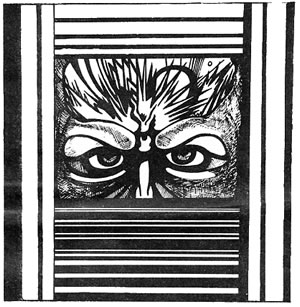
 |
Online
Archive
|
| Issue 1 - December 1971 |
| Forming The Heart Of Art |
| Art
has always been a barometer of civilised society. Artists have always
consciously or unconsciously reflected it; and some even reflect on these
reflections and accordingly go out to influence society; after arriving
at some particular strong moral conviction, they are the artists who will
lay bare their art and themselves for the good of man.
Today, artists are pulled along by twentieth century technology, by its sophisticated glossy package of attractiveness, its apparent clean-cut ideals. Through increasing technology which expands at a galloping pace with wholesale alienation following through the length and breadth of society; human life has hence steadily become more and more devalued. All the subtle qualities are continually strangled out by the spiritual pythons of Progress and its counterpart Commercialism whilst the ever growing infant Specialisation feeds on and on and on. These creatures have wrapped themselves tightly round the art education system and their minions who operate it, who get really to work selling the myth that this is the age of free expression. All these teachers, lecturers and art education theorists subtly condition all those who get put into their educational grasp. They hold that it is old-fashioned to express yourself all over the place. Art must be Abstract and modern, the more obscure and distant the better. The public being snobbishly fobbed off by the excuse of an idea that 'they' are always behind new ideas in art and it is not worth the effort explaining it to them. So the galleries echo the middle-class institutions where live the whole sickeningly elite society of artists who are protected by this shield: "They will never understand", so safe that they can do whatever takes their conceptual fancy. 
For those rare creatures who want to express themselves (and a considerable number will be from the unenlightened masses) who want to voice an individual expression, they are told that it is better to use the nondescript "systems of analysis" ... "patterns of thought" to "conceptualise". This leads to a reducing of these individuals' own identity after going through many of their mechanically soul-crushing methods: methods that hang on the frames of most art foundation courses. The only thing a powerful expressionistic individual can cling to, is an intuitive feeling that something is drastically wrong. The feeling will be mystical and not 100% rational. If you have it, or vaguely feel it, then hang on to it. It has been said of modern times that we are all in danger of abstracting ourselves out of existence, so defy this devouring whirlpool. A good pointer to this obliterating abstraction is in the visual arts. In painting and sculpture the human figure has been constantly obscured by many a "Systematic analysis". Until now it is laughed at by those minions of the educational structure as a thing of the past and accordingly it is kept in the background as an outmoded form of antiquity. But this form's resurrection will come about, because of the extremes this tyranny's abstracting vacuum has evolved to. The human figure has always been a human universal constant: for it is the only form that can encompass all that is human; whether it is feelings from joy to sorrow, from a human's personal ideas to human ideas. The feeling of a whole age to one being's own state is just a flicker of time. However, the development of twentieth century sophistication, rationalisation, regimentation, specialisation and every other unnaturalisation that have come about, have attempted either to totally destroy this form or obscure it. In the visual arts the new Hard Edge painting, which can be called an uncompromising geometrication of this Universal Human element has been to the fore of this mathematical trend. More directly of a geometrication of each propagator of this style, are the artists who happily paint the thick academic colour field bars around their hearts, and all drown colourfully on many broad canvas seas. Art about the media of commercialism has evolved a mimicking of it, in which a cheap happy-go-lucky manner is accepted because it represents symbolically this age. Though after the intellectuals have had their mental fangs into it, we have now an art that has become one held in high esteem by all who live in their ivory galleries. A great work of art should uplift a person's soul but how can it when the observer is classed as backward, when the work is totally an undiluted uncompromising statement, when the work is not about human beings' states of existence, about souls (that appear to need recognising)! Surely, when the work is a giant can of beans, is when there will come about a revolution of revulsion. Ken Swingewood 1971 |